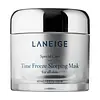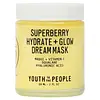What's inside
What's inside
 Key Ingredients
Key Ingredients

 Benefits
Benefits

 Concerns
Concerns

 Ingredients Side-by-side
Ingredients Side-by-side

Water
Skin ConditioningPropanediol
SolventAvena Sativa Kernel Extract
AbrasiveGlycerin
HumectantCyclopentasiloxane
EmollientDimethicone
EmollientSqualane
EmollientCyclohexasiloxane
EmollientCeratonia Siliqua Fruit Extract
MaskingHibiscus Abelmoschus Seed Extract
MaskingTillandsia Usneoides Extract
Skin ConditioningAdenosine
Skin ConditioningHydrogenated Lecithin
EmulsifyingC12-16 Alcohols
EmollientGlyceryl Caprylate
EmollientDextrin
AbsorbentDimethicone/Vinyl Dimethicone Crosspolymer
Skin ConditioningDipalmitoyl Hydroxyproline
Skin ConditioningButylene Glycol
HumectantCetearyl Glucoside
EmulsifyingCetearyl Alcohol
EmollientEthylhexylglycerin
Skin ConditioningXanthan Gum
EmulsifyingTheobroma Cacao Extract
Skin ConditioningPalmitic Acid
EmollientPolysorbate 20
EmulsifyingPvp
Emulsion StabilisingPEG-240/Hdi Copolymer Bis-Decyltetradeceth-20 Ether
StabilisingHydroxyethyl Acrylate/Sodium Acryloyldimethyl Taurate Copolymer
Emulsion StabilisingDisodium EDTA
Phenoxyethanol
PreservativeParfum
MaskingWater, Propanediol, Avena Sativa Kernel Extract, Glycerin, Cyclopentasiloxane, Dimethicone, Squalane, Cyclohexasiloxane, Ceratonia Siliqua Fruit Extract, Hibiscus Abelmoschus Seed Extract, Tillandsia Usneoides Extract, Adenosine, Hydrogenated Lecithin, C12-16 Alcohols, Glyceryl Caprylate, Dextrin, Dimethicone/Vinyl Dimethicone Crosspolymer, Dipalmitoyl Hydroxyproline, Butylene Glycol, Cetearyl Glucoside, Cetearyl Alcohol, Ethylhexylglycerin, Xanthan Gum, Theobroma Cacao Extract, Palmitic Acid, Polysorbate 20, Pvp, PEG-240/Hdi Copolymer Bis-Decyltetradeceth-20 Ether, Hydroxyethyl Acrylate/Sodium Acryloyldimethyl Taurate Copolymer, Disodium EDTA, Phenoxyethanol, Parfum
Water
Skin ConditioningGlycerin
HumectantHelianthus Annuus Seed Oil
EmollientIsopropyl Myristate
EmollientGlyceryl Stearate
EmollientBetaine
HumectantCetyl Alcohol
EmollientStearic Acid
CleansingTetrahexyldecyl Ascorbate
AntioxidantOpuntia Tuna Flower/Stem Extract
Skin ConditioningEuterpe Oleracea Fruit Extract
Lycium Barbarum Fruit Extract
AstringentAristotelia Chilensis Fruit Extract
Skin ConditioningMoringa Oleifera Leaf Extract
Skin ConditioningGlyceryl Stearate Citrate
EmollientTocopheryl Acetate
AntioxidantGlyceryl Laurate
EmollientSqualane
EmollientCarbomer
Emulsion StabilisingHyaluronic Acid
HumectantAllantoin
Skin ConditioningPanthenol
Skin ConditioningEthylhexylglycerin
Skin ConditioningXanthan Gum
EmulsifyingPhenoxyethanol
PreservativeRiboflavin
Cosmetic ColorantTriethyl Citrate
MaskingCitrus Aurantium Dulcis Peel Oil
MaskingGamma-Undecalactone
PerfumingGamma-Decalactone
PerfumingTocopherol
AntioxidantLimonene
PerfumingWater, Glycerin, Helianthus Annuus Seed Oil, Isopropyl Myristate, Glyceryl Stearate, Betaine, Cetyl Alcohol, Stearic Acid, Tetrahexyldecyl Ascorbate, Opuntia Tuna Flower/Stem Extract, Euterpe Oleracea Fruit Extract, Lycium Barbarum Fruit Extract, Aristotelia Chilensis Fruit Extract, Moringa Oleifera Leaf Extract, Glyceryl Stearate Citrate, Tocopheryl Acetate, Glyceryl Laurate, Squalane, Carbomer, Hyaluronic Acid, Allantoin, Panthenol, Ethylhexylglycerin, Xanthan Gum, Phenoxyethanol, Riboflavin, Triethyl Citrate, Citrus Aurantium Dulcis Peel Oil, Gamma-Undecalactone, Gamma-Decalactone, Tocopherol, Limonene
 Reviews
Reviews

Ingredients Explained
These ingredients are found in both products.
Ingredients higher up in an ingredient list are typically present in a larger amount.
Ethylhexylglycerin (we can't pronounce this either) is commonly used as a preservative and skin softener. It is derived from glyceryl.
You might see Ethylhexylglycerin often paired with other preservatives such as phenoxyethanol. Ethylhexylglycerin has been found to increase the effectiveness of these other preservatives.
Glycerin is already naturally found in your skin. It helps moisturize and protect your skin.
A study from 2016 found glycerin to be more effective as a humectant than AHAs and hyaluronic acid.
As a humectant, it helps the skin stay hydrated by pulling moisture to your skin. The low molecular weight of glycerin allows it to pull moisture into the deeper layers of your skin.
Hydrated skin improves your skin barrier; Your skin barrier helps protect against irritants and bacteria.
Glycerin has also been found to have antimicrobial and antiviral properties. Due to these properties, glycerin is often used in wound and burn treatments.
In cosmetics, glycerin is usually derived from plants such as soybean or palm. However, it can also be sourced from animals, such as tallow or animal fat.
This ingredient is organic, colorless, odorless, and non-toxic.
Glycerin is the name for this ingredient in American English. British English uses Glycerol/Glycerine.
Learn more about GlycerinPhenoxyethanol is a preservative that has germicide, antimicrobial, and aromatic properties. Studies show that phenoxyethanol can prevent microbial growth. By itself, it has a scent that is similar to that of a rose.
It's often used in formulations along with Caprylyl Glycol to preserve the shelf life of products.
Squalane is an emollient that helps the skin hold onto moisture. It's an oily liquid that occurs naturally in certain types of fish and plant oils.
Because squalane boosts hydration in the skin, it also comes with plenty of benefits: it is an antioxidant and can help fight free radicals and skin damage. Squalane is also found to have a detoxifying effect when applied.
Squalane comes from squalene, which occurs naturally within the sebum of our skin. It is one of the oils our skin produces to keep itself hydrated. Squalane is the hydrogenated version of squalene and has a longer shelf life.
Research shows that squalane is non-irritating (even at 100% concentration).
In general, it's a fantastic ingredient. It does a great job at hydrating the skin, and it's suitable for those with sensitive skin.
The source of squalane may impact malassezia / fungal acne. This is because olive oil derived squalane can contain impurities such as fatty acids and plant waxes. Sugarcane derived squalane is recommended for anyone with malassezia concerns.
Is squalane vegan?
This depends on the source. Squalane can be derived from both plants and animals. Most squalane used in skincare comes from plants.
Please note: the source of squalane is only known if disclosed by the brand. We recommend reaching out to the brand if you have any questions about their squalane.
Read more about squalene with an "e".
Is squalane an oil?
Squalane is often called an oil, but it’s technically not; it’s a hydrocarbon, meaning it’s only made of carbon and hydrogen, unlike true oils which are triglycerides made of fatty acids and glycerol.
The term “oil-free” isn’t regulated, so companies can define it however they want. Some exclude all oils, while others just avoid mineral oil or comedogenic oils.
While some people avoid oils thinking they cause breakouts, the right kind of oil (or oil-like ingredient like squalane) can actually help balance and hydrate your skin. It’s worth testing out simple oils or squalane to see what works best for your skin.
Learn more about SqualaneWater. It's the most common cosmetic ingredient of all. You'll usually see it at the top of ingredient lists, meaning that it makes up the largest part of the product.
So why is it so popular? Water most often acts as a solvent - this means that it helps dissolve other ingredients into the formulation.
You'll also recognize water as that liquid we all need to stay alive. If you see this, drink a glass of water. Stay hydrated!
Learn more about WaterXanthan gum is used as a stabilizer and thickener within cosmetic products. It helps give products a sticky, thick feeling - preventing them from being too runny.
On the technical side of things, xanthan gum is a polysaccharide - a combination consisting of multiple sugar molecules bonded together.
Xanthan gum is a pretty common and great ingredient. It is a natural, non-toxic, non-irritating ingredient that is also commonly used in food products.
Learn more about Xanthan Gum